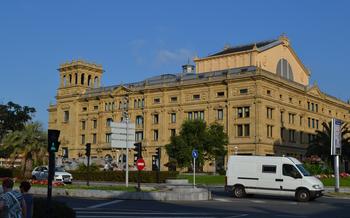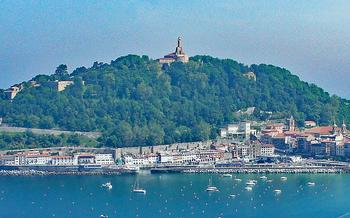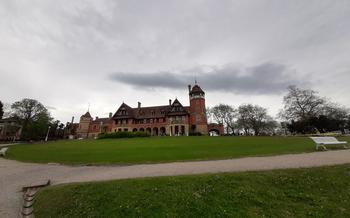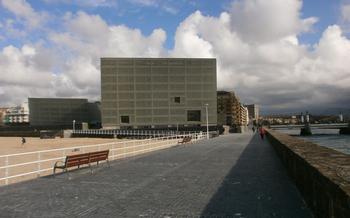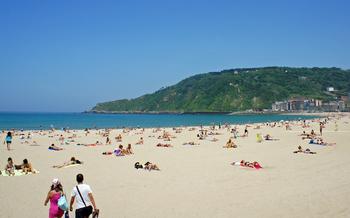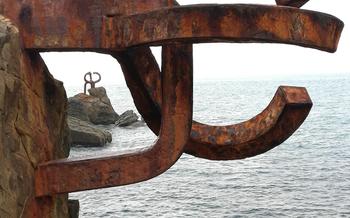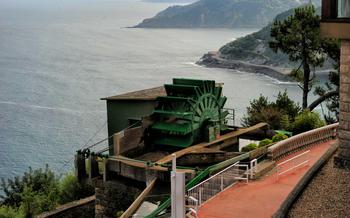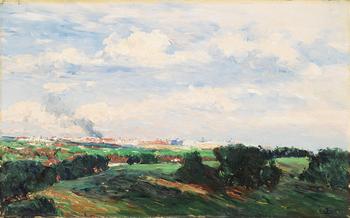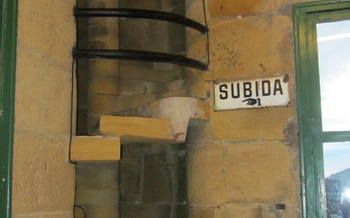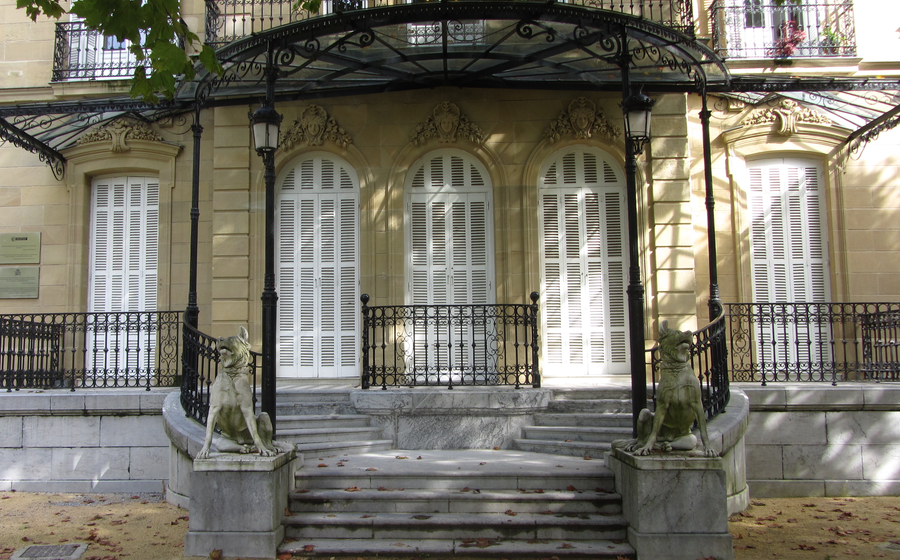
Palacio de Aiete
- Historical Background and Significance of the Palace
- Admire the Architectural Masterpiece
- Stroll Through the Picturesque Gardens
- Discover Hidden Gems: Sculptures and Landmarks
- Unveil Panoramic City Views
- Immerse in Royal Traditions: Past Events and Celebrations
- Engage with Current Exhibitions and Events
- Witness the Changing Face of the Palace
- Capture the Palace's Essence Through Photography
- Insider Tip: Explore the Secret Tunnel
Historical Background and Significance of the Palace
Nestled amidst the picturesque hills ofs rich history and royal legacy. Built in the late 19th century, this magnificent palace was once the summer residence of the Spanish royal family, serving as a tranquil retreat for monarchs and their entourage. Its construction was commissioned by Queen María Cristina, wife of King Alfonso XII, who sought a serene escape from the bustling city center. The palace's grandeur and strategic location on the outskirts of San Sebastián made it an ideal retreat for the royal family to relax and entertain guests.
Admire the Architectural Masterpiece
The Palacio de Aiete stands as a testament to architectural brilliance, seamlessly blending elements of Renaissance, Neoclassical, and Baroque styles. Its striking facade, adorned with elegant balconies and intricate carvings, captivates the eye. Inside, visitors are greeted by a grand staircase, soaring ceilings adorned with frescoes, and polished marble floors. Each room showcases unique features, from ornate chandeliers and tapestries to exquisite furnishings that reflect the refined taste of its former royal occupants.
The palace's strategic location on a hilltop offers panoramic views of the city, the coastline, and the surrounding mountains. Its vast gardens, meticulously landscaped with fountains, sculptures, and colorful flower beds, provide a tranquil oasis amidst the urban landscape. The harmonious interplay of architecture, nature, and history creates a truly enchanting experience for visitors to the Palacio de Aiete.
Stroll Through the Picturesque Gardens
The Palacio de Aiete boasts stunning gardens that are a testament to the palace's grandeur and elegance. As you stroll through these verdant havens, you'll encounter a diverse array of plant life, carefully arranged to create a harmonious and visually appealing landscape. Notable highlights include the Rose Garden, where vibrant blooms in every shade of pink and red create a captivating display, and the Japanese Garden, a tranquil oasis inspired by the serenity of traditional Japanese gardens.
The gardens not only add to the aesthetic beauty of the palace but also play a significant role in its overall design and ambiance. They provide a sense of tranquility and seclusion, inviting visitors to escape the hustle and bustle of city life and immerse themselves in the serene beauty of nature. The gardens also serve as a natural extension of the palace's interior spaces, offering seamless transitions between indoor and outdoor living areas.
Discover Hidden Gems: Sculptures and Landmarks
Within the serene grounds of the Palacio de Aiete, a treasure trove of sculptures and landmarks awaits discovery. These artistic masterpieces, scattered throughout the lush gardens, add a touch of grandeur and historical significance to the palace's ambiance.
One of the most notable sculptures is the bust of Queen Maria Cristina, who played a pivotal role in the construction of the palace. The bust, crafted with intricate detail, captures the queen's regal demeanor and serves as a testament to her influence on the city of San Sebastián.
Another highlight is the sculpture of the "Mermaid of Aiete," a mythical creature that has become a symbol of the palace and its enchanting surroundings. The mermaid, depicted with flowing hair and a captivating gaze, invites visitors to delve into the realm of fantasy and folklore that permeates the palace grounds.
Among the landmarks, the "Fountain of the Four Seasons" stands out as a testament to the palace's rich history. The fountain, adorned with intricate carvings and sculptures representing the four seasons, offers a refreshing respite and a chance to contemplate the beauty of nature.
These sculptures and landmarks are not mere decorative elements; they are integral to the storytelling of the Palacio de Aiete. They provide glimpses into the lives of past royal residents, symbolize important historical events, and add layers of cultural significance to the palace's legacy.
Unveil Panoramic City Views
The Palacio de Aiete offers breathtaking panoramic views of San Sebastián and its surroundings. The palace grounds are elevated, providing visitors with a unique perspective of the city. Multiple viewpoints within the gardens offer stunning vistas. The most popular viewpoint is the Mirador de la Reina (Queen's Viewpoint), named after Queen Maria Cristina. From this vantage point, visitors can admire the city's iconic landmarks, including La Concha Beach, the Kursaal Congress Centre, and Mount Urgull.
These viewpoints are not just about the views; they are also about experiencing the palace's history and grandeur. Imagine standing in the same spot where royalty once stood, taking in the same breathtaking vistas. The viewpoints provide a unique opportunity to connect with the palace's past and appreciate its significance in the city's history.
To capture the best photographs, visit the viewpoints during the golden hours of sunrise and sunset. The warm light casts a magical glow on the city, creating a picturesque backdrop for your shots. Remember to bring a wide-angle lens to capture the expansive views and a tripod for stability.
Immerse in Royal Traditions: Past Events and Celebrations
The Palacio de Aiete has witnessed a multitude of grand events and celebrations throughout its illustrious history. These occasions were not merely social gatherings but significant events that left an indelible mark on San Sebastián's cultural and social fabric. From lavish balls and royal weddings to official receptions and state dinners, the palace's opulent halls and manicured gardens provided a backdrop for some of the city's most memorable moments.
One of the most notable events held at the palace was the wedding of King Alfonso XIII to Princess Victoria Eugenia of Battenberg in 190The grand ceremony, attended by royalty and dignitaries from across Europe, transformed San Sebastián into a festive city adorned with colorful decorations and jubilant crowds. The palace's gardens were illuminated with thousands of lights, creating a magical atmosphere for the royal couple's grand entrance.
Another significant event was the visit of Queen Victoria of England in 190The queen's presence in San Sebastián was a testament to the city's growing popularity as a royal destination. During her stay, Queen Victoria enjoyed the palace's luxurious accommodations and participated in various social events, including a grand ball held in her honor.
These are just a few examples of the many historical events and celebrations that have taken place within the walls of the Palacio de Aiete. Each event holds a unique story, providing a glimpse into the rich history and cultural significance of this remarkable palace.
Engage with Current Exhibitions and Events
The Palacio de Aiete has undergone a remarkable transformation from a royal residence to a vibrant cultural center, hosting an array of exhibitions and events that captivate and inspire visitors. These events delve into the rich history, art, and culture of San Sebastián, showcasing the city's diverse heritage and contemporary creative spirit.
Exhibitions at the palace range from historical retrospectives to contemporary art installations, celebrating the works of local, national, and international artists. These exhibitions provide a platform for emerging talents and established masters to showcase their creativity and engage with the public.
The palace also hosts a variety of cultural events throughout the year, including concerts, lectures, workshops, and film screenings. These events bring together artists, intellectuals, and enthusiasts from across the region, fostering a vibrant cultural dialogue and enriching the city's arts scene.
To stay updated on upcoming exhibitions and events, visitors can check the palace's official website or social media pages. The palace also offers guided tours that provide insights into the history, architecture, and cultural significance of this remarkable venue.
Witness the Changing Face of the Palace
Over the centuries, the Palacio de Aiete has undergone numerous architectural changes and renovations, reflecting the evolving needs and tastes of its royal residents and the changing role of the palace itself. In the 19th century, extensive renovations were carried out to transform the palace into a more comfortable and modern residence for the royal family. These renovations included the addition of new wings, the expansion of the gardens, and the incorporation of modern amenities such as electricity and running water. In the 20th century, the palace underwent further renovations to adapt it to its new role as a cultural center. These changes included the creation of exhibition spaces, a library, and an auditorium, as well as the restoration of the palace's historic interiors. Today, the Palacio de Aiete stands as a testament to its rich history, blending architectural elements from different eras and showcasing the palace's ability to adapt to changing circumstances while retaining its unique charm and grandeur.
Capture the Palace's Essence Through Photography
Golden Hour Magic: The warm glow of sunrise and sunset casts a magical light on the Palacio de Aiete, creating an ethereal atmosphere. Capture the palace bathed in this golden light for a truly stunning shot.
Play with Perspectives: Experiment with different angles and perspectives to create dynamic compositions. Try shooting from below to emphasize the palace's grandeur, or capture it from a higher vantage point for a panoramic view.
Focus on Details: The palace is adorned with intricate architectural details, from its ornate balconies to its sculpted facades. Zoom in to capture these details and showcase the craftsmanship that went into creating this masterpiece.
Embrace Reflections: Take advantage of the nearby pond to capture stunning reflections of the palace. The mirrored image creates a surreal and captivating effect, adding depth and drama to your photographs.
Capture the Gardens: The palace gardens are a photographer's paradise, with colorful blooms, lush greenery, and sculptures. Wander through the gardens, capturing the vibrant colors and serene atmosphere.
Insider Tip: Explore the Secret Tunnel
Hidden beneath the Palacio de Aiete lies a fascinating secret: a tunnel that once served as a discreet passageway connecting the palace to the city of San Sebastián. Constructed in the 19th century, this tunnel played a crucial role in the palace's history, allowing royal residents and guests to enter and exit the palace without being seen.
Today, visitors can explore this hidden gem, stepping back in time as they traverse the tunnel's dimly lit corridors. The tunnel's entrance is concealed within the palace gardens, and visitors can request access from palace staff. While exploring the tunnel, one can't help but imagine the clandestine meetings and covert operations that may have taken place within its walls.
Emerging from the tunnel, visitors find themselves in the heart of San Sebastián, just a short walk from the city's bustling streets and vibrant atmosphere. It's a unique and unforgettable experience that offers a glimpse into the palace's intriguing past.

